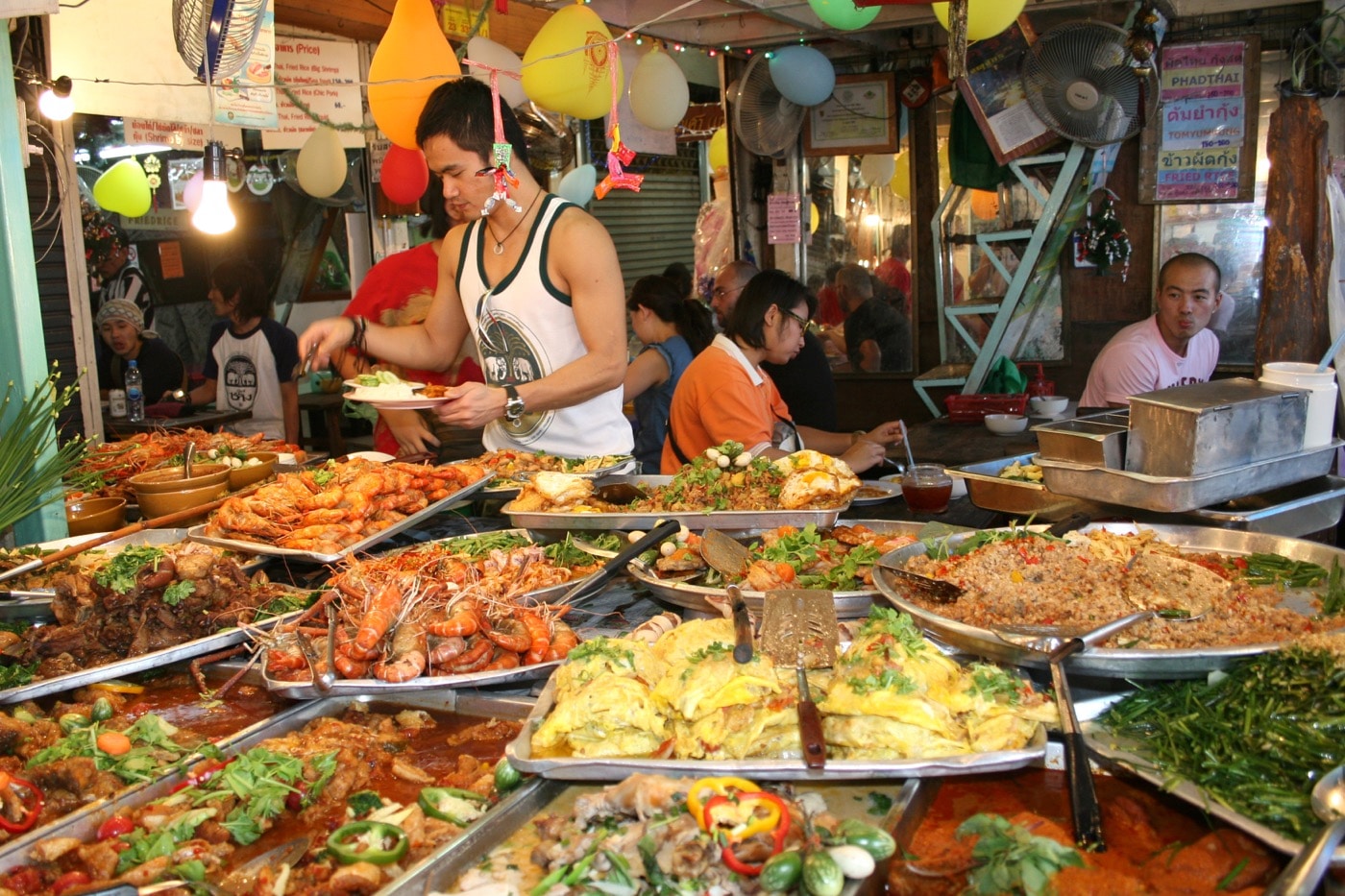I was reluctant to visit Thailand thanks to its reputation as a haven for sexpats – old geezers with their drooping, chicken skin arms around the shoulders of girls and boys forty years younger. But when I realized how much I loved the spices of Southeast Asia, and legitimate massages, I decided to chance it.
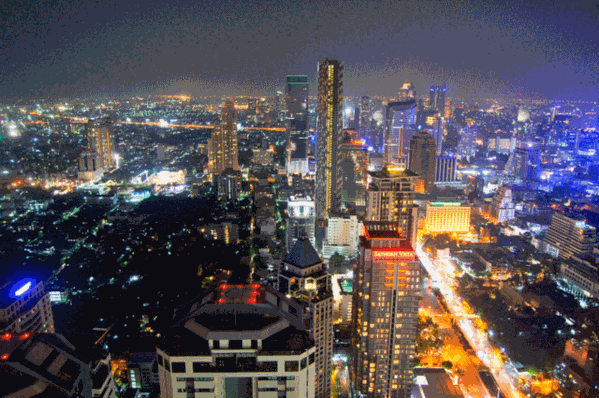
The cuisines of Thailand – northern dishes influenced by Chinese peasant hot pot cooking; coastal dishes with fish, shellfish, and coconut milk; western dishes that owe something to Islamic traders; and eastern dishes that are as subtle as what you find in Vietnam – had made their way to the States. This was due in large measure to the R&R–Rest and Relaxation–of the Vietnam era. Bangkok was the place GI’s went in order to “rest and relax” away from the horrors of war. They returned stateside with a hunger for Thai food, sometimes with spouses or girlfriends, and then the U.S. government relaxed immigration laws and Thais began to arrive in North America.
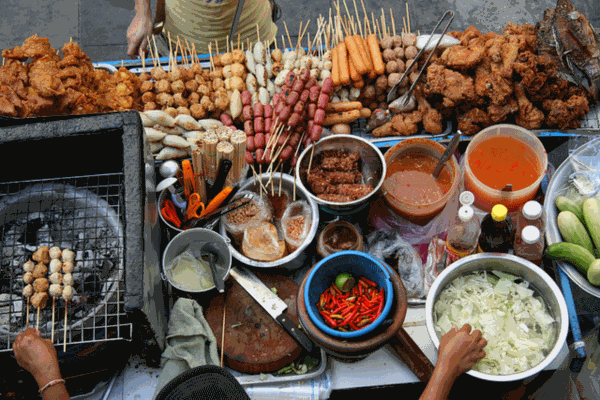
I love Thai food–the subtle spices, the fiery peppers and the exquisite use of vegetables that derives from the Buddhist tradition. I also love the noodles and those deeply flavorful soups–but wanted to try them in their place of origin since what we often find in the U.S. is a watered down or homogenized version. I booked flights and rooms in Bangkok for a few nights and after hours of listening to Pimsleur language tapes, I was ready. I was on a mission to eat great Thai food and could now say, “Hello, How are you?” and “Goodbye.” As part of the planning, I contacted a few chefs I know in the U.S., all of whom had spent time cooking and eating in Bangkok. They all said to stroll the streets and allow my senses–olfactory and sight—to be my guide. Not one recommended a single restaurant.
On the flight over which takes (ballpark) twenty-two hours and deposits you in a time zone eleven hours ahead of the East Coast, they offered an array of movies, one being “Hangover, Part Two,” which takes place in Bangkok. In the film three Americans get completely drunk, dissolute, lost, disoriented, and so out of control that the most normal one of them wakes up with a tribal tattoo on the side of his face a la Mike Tyson. Not reassuring. But when the taxi sped from the new (just six years old) and ultramodern Suvarnabhumi Airport in the direction of downtown Bangkok, I was happy to realize – it was only a movie!
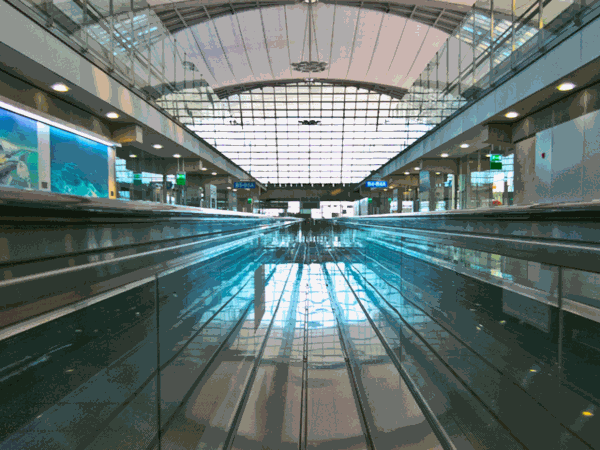
As the driver maneuvered his way off the elevated highway lined with gold statuettes and billboards of the King and royal family into the city, Bangkok seemed like one big street fair of beautiful food. All around me I saw people slurping noodles from deep bowls, dipping skewered meats and chicken into sauces, and enjoying grilled shrimp. I lowered the window. What greeted me were wafting aromas of frying oil, ginger, onions, garlic, coriander, sugar, and pepper. From the looks of things, too, prices were low. A half-dozen chicken skewers and an iced tea was about $2. A bowl of soup? $2. Fresh fruit? Fifty cents. And there was no neighborhood, no restaurant row, no four star establishment that was better than everything else. Bangkok is extremely clean, inviting, and hungry. Chances are that no matter where you stop for a quick bite, you’ll be satisfied. I would even say that Bangkok is a city that entertains itself with food.
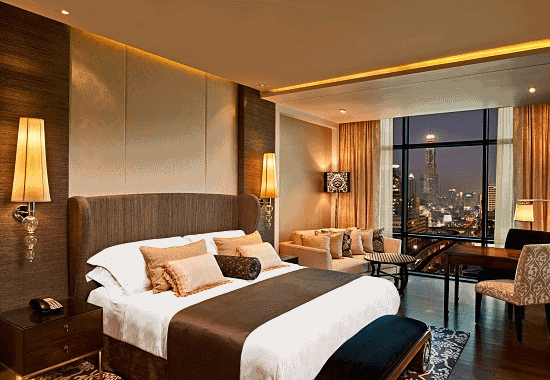
The U.S. dollar still has good buying power in Thailand. I booked at the St. Regis where, for $250 a night, I had a huge room overlooking the park, access to the wonderful outdoor pool, and a buffet breakfast that was flat out shocking in its sumptuousness. Breakfast consisted of both Eastern and Western dishes – bacon and eggs or dumplings, baked ham or Pad Thai, French toast or soup and noodles.
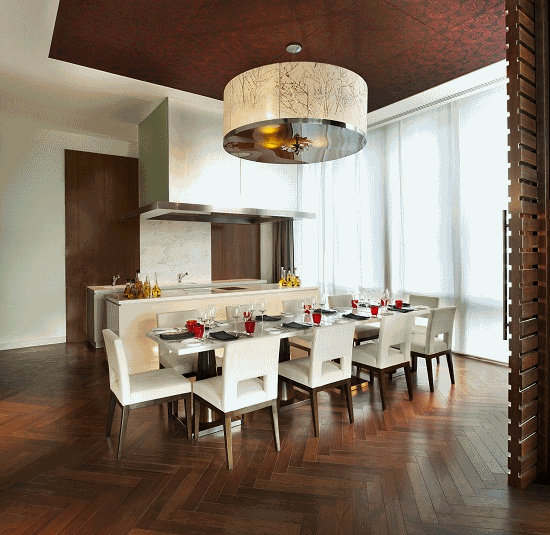
On that first morning and on all subsequent days I came to understand it was all about pacing oneself. Everything was so flavorful that once I finished one dish, I’d be satisfied until I spied another place to try something different. Your palate will be stimulated in Bangkok by the powerful sensuality of the food and I tried to keep satisfaction at bay in order to keep eating. Just strolling in the park, past the joggers and the outdoor yoga classes, I found myself winding up at a little table beside a cart where a couple stirred a pot of soup, dropped in long noodles, added chopped chicken and sprinkled coriander and pepper over everything. The differences were immediately evident between Thai food there and what you’d get most of the time in the U.S. At home Thai food is often sugary with a liberal use of vinegar and mild spices while in Bangkok, sugar is in the background of most dishes, and sometimes not present at all. Also, if you like fiery flavors that are distinctive rather than overwhelming, you’ve come to the right place. You can taste a symphony of heat that doesn’t overwhelm the dish with each hot pepper a subtle addition. I brought back a small pouch of crushed and dried dark red peppers that had a very smoky taste. Just a pinch was all that was needed to wake up a dish.
Just outside the hotel and in every neighborhood, little mobile stands sell fresh mango, watermelon, and pineapple that the vendors slice for you on the spot. You point to what you want, and it’s placed in a small plastic bag. You use toothpicks to spear the fruit as you walk around sightseeing, a feast even while on the go. Bangkok is a great walking city. Every day I spent hours pounding the pavements, exploring the markets and of course, sampling the carts. When I got tired, I took the ultra modern sky train above the streets as traffic is perpetually gridlocked. The markets sell beautiful fruits, vegetables, and herbs arranged in rows with prices posted. I joined discerning customers and took in the seductive aromas.
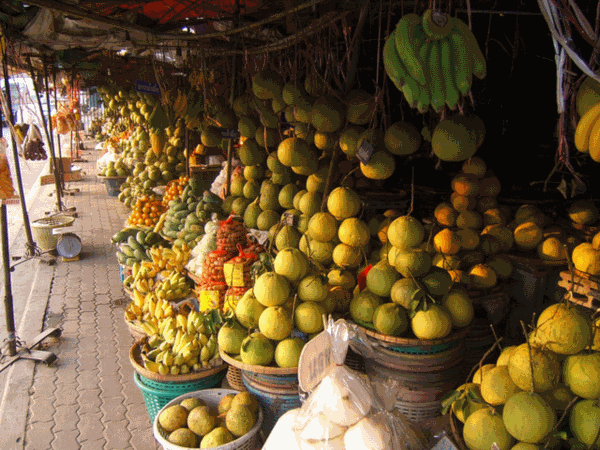
Thailand is famous, too, for its night markets. They are arranged the same as during the day but after hours you find young couples on dates, hypnotic live music and crowds dancing in swirling circles in a kind of country western way. Thailand has a reputation for being outrageous but it’s not. It’s a deeply conservative country where you rarely see public displays of emotion let alone affection. But what it is – is tolerant. Inspired by the Buddhist tradition, Thai people allow you to be yourself. Just be respectful, quiet, and discreet.
Having spent most days eating in markets and at street stalls, I finally made my way to a couple of restaurants. The chefs I’d spoken to before leaving had given me no recommendations, but I myself remembered David Thompson. Originally from Australia, Thompson wrote one of the world’s best cookbooks, and it happens to be about Thailand. He also opened Nahm in London, the world’s only Michelin starred Thai restaurant, with one star to its credit. Recently he’d opened another Nahm, this one in The Metropolitan Hotel in Bangkok. The setting is elegant and sophisticated, yet playful. It’s a tough reservation to snag but I booked a month in advance. From the lychee martinis to the fruit desserts, Nahm was amazing.
A dish of beef curry was delicious in large part due to the meat being Australia Wagyu – high in fat, textured, and as flavorful as foie gras. A chicken dish was super-hot and complex.
Bo.Lan was the setting for another dinner. Run by the former sous chef from Nahm, it’s located in a tranquil courtyard in a lovely and quiet residential neighborhood. The setting is magical – just two rooms that evoke a pre-war serenity. This was a place where vegetables took pride of place evidenced in a six course vegetarian tasting menu that was sumptuous and delicious as it took full advantage of Thailand’s abundance.
As you taste, you savor. Thailand’s cuisines will only become more influential globally as people recognize that their innate vegetarian ingredients are health conscious while the small portions and spices create harmony in the various foods. And of course, there’s the R&R that goes with them!
The country code for Thailand is 66.
Where to Stay:
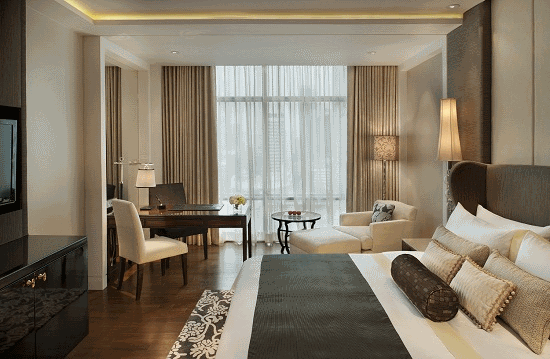
The St. Regis – Located in an upscale neighborhood in the heart of Bangkok and with a stellar staff. 159 Rajadamri Road, Bangkok; 66 2 207 7777; www.starwoodhotels.com/stregis/bangkok
The Metropolitan Hotel – Blends stylish sophistication and luxurious design. 27 South Sathorn Road Tungmahamek, Sathron, Bangkok; 66 2 625 3333; www.comohotels.com/metropolitanbangkok
Where to Eat:
Nahm – Literally, textbook Thai food from the world’s best practitioner of its varied regional dishes. 27 Sathorn Road, Bangkok; 66 2 625 3388; www.comohotels.com
Bo.Lan. – The menu relies heavily on local, organic ingredients from farms and suppliers known personally to the chefs. 42 Sukhumvit, 26 Soi Pichai Ronnarong Songkram Klongtoey, Bangkok; 66 2 260 2962
What to Do:
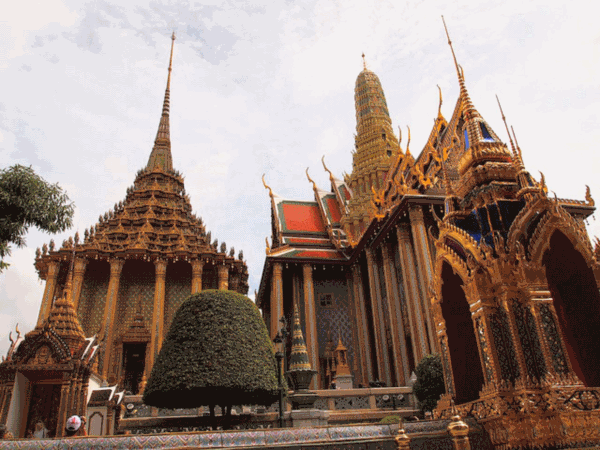
Hire your own boat and captain and motor on the river to see Buddhist temples and shrines. Your hotel will help arrange this for you.
Strolling the streets affords great pleasure. There are hundreds of clubs, pleasant or naughty.
Note from the author:
Thailand is governed by a monarchy that makes the rules. Nightlife tends toward karaoke in local bars and restaurants, public dancing in groups, and indoor fireworks. This is not a place where you should express public affection, make loud conversation, or assume immunity. And don’t even think of insulting the royal family.

